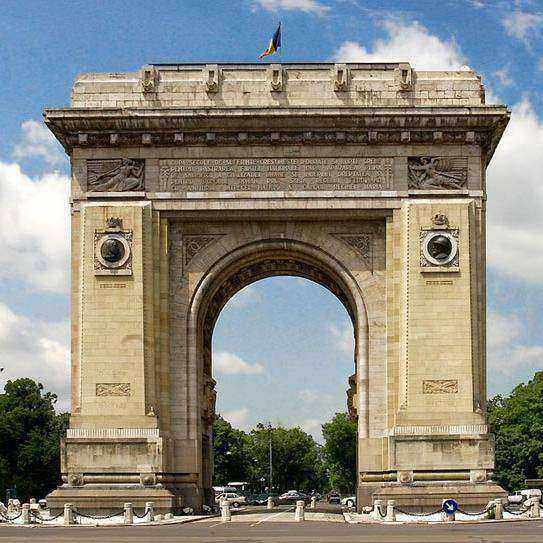Description
From: Bucharest, Monuments, Muntenia
Alongside the Coronation Cathedral in Alba Iulia, The Marasesti Mausoleum and a few other important Romanian monuments, the Triumphal Arch is among the distinguished monuments of the Romanian nation which attest to Romania’s participation in World War I, on the side of the Allied Powers; as with other monuments in Bucharest, the Triumphal Arch was built following the proclamation of the Union.
HISTORY OF THE TRIUMPHAL ARCH
Initially built in 1922, out of wood and stucco, it was restored, and the new construction was made of stone. This event took place over two years, 1935 and 1936, and is the work of the architect Antonescu Petre.
The same Antonescu Petre built it in 1922, to commemorate the elevation of Ferdinand I and Marie to king and queen of Romania. Because the time allotted for the building of the commemorative construction was short, a compromise was reached: only the core of the monument was made of reinforced concrete, while the exterior finish was made of stucco (plaster mixed with glue). Over time, the Triumphant Arch deteriorated, corresponding less and less with the Little Paris image held by the Bucharest of the inter-war period, which was representative of the time.
As a result, many voices asked that the monument be demolished. However, demolishing the monument would have made the event it commemorated less representative, so the best solution was to restore it and replace the exterior façade with elements made of Ruschita marble, stone and bronze.
The financial contributors to the new façade of the Triumphant Arch were numerous associations and combatants who fought in World War I. Over 7 million lei were needed from these contributors, so that on December 1st 1936, exactly 18 years after the union of Transylvania with Romania, this momentous event could be commemorated, and the new Triumphant Arch could be inaugurated. King Carol II and his mother, Queen Marie, and the heir Prince Michael, as well as members of the Romanian Government and numerous national and international esteemed guests were present at the event.
The elements of the new monument façade are the two bronze medallions on the southern face, representing the faces of King Ferdinand and Queen Marie (the two medallions abandoned the façade of the Triumphant Arch for a time, during the communist regime, and were replaced by large bronze flowers; in 1989, the medallions bearing the images of King Ferdinand and Queen Marie retook their place). Above every portrait there is an embossed image of a Romanian Victory, works of the artists Baraschi and Constantinescu. C. Baraschi is also the author of two sculptures on the northern face of the monument, called “Bravery” and “Faith”.
The lateral sides contain proclamations by King Ferdinand to the Romanian people, from the time when the country participated in the War, as well as the coronation proclamation of Alba Iulia.
HOW TO GET TO THE TRIUMPHANT ARCH?
The Triumphant Arch is located in Bucharest’s District 1, on Kiseleff Road.
It is open to visitors during various important events taking place in Bucharest every year: Army Days, Aviators’ Days, Bucharest’s Days. Inside, it hosts 4 interesting exhibits:
- The Great War for the Reunification of the Nation
- Heraldry of the Great Boyar Families (bronze effigies, photographs)
- The Triumphant Arch in pictures
- The Great Union of 1918 (1:1 replicas of the crowns and royal scepter, photographs).
